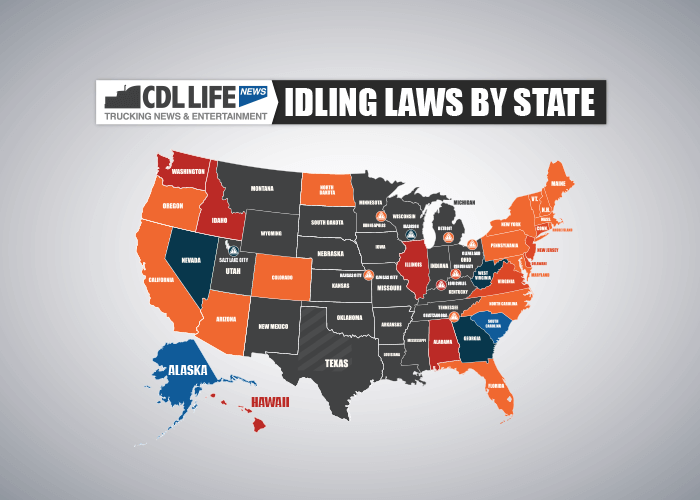Idling Laws By State

Idling laws tend to differ greatly across the United States, and can be a little tricky to remember (especially in states with larger, harshly regulated cities)! Check out this quick reference map to find idling laws fast!

State-By-State Idling Law Exemptions
Arizona: Traffic and adverse weather conditions. Commercial passenger transportation or school purposes can idle up to 30 minutes in any 60-minute period. If temperatures are above 75 degrees, passenger buses can idle up to 60 minutes in any 90-minute period. Idled during DOT-mandated rest periods (U.S. 49 CFR Part 395) and Arizona Department of Transportation Regulation (Arizona R17-5-202).
Colorado: A driver may idle, if the temperature is less than 10 degrees, for 20 minutes in any 60-minute period, when he or she is in need of a warm or cool sleeper during rest or sleep periods at a safety rest area as defined under 23 CFR 752.3, trucking terminal, truck stop, or state-designated rest area or when used to heat or cool a sleeper berth compartment during a rest or sleep period at a legal parking location that is at least 1,000 ft from residential housing, a school, a daycare facility, or a hospital.
Connecticut: A driver may idle if the temperature is less than 20 degrees.
Delaware: A driver may idle if the temperature is between -10 and 32 degrees for no longer than 15 consecutive minutes. A driver may also idle is the temperature is below -10 degrees.
Georgia: [Macon] Drivers may idle for a maximum of 25 minutes is the temperature is less than 32 degrees.
Illinois: Cities: Aux Sable, Goose Lake, Oswego Counties: Cook, DuPage, Lake, Kane, McHenry, Will, Madison, St. Claire, Monroe- Drivers may idle for 30 minutes in any 60-minute period while they’re waiting to load or unload freight. There is no limit if the temperature is less than 32 degrees or greater than 80 degrees.
Maine: Drivers may idle for the purpose of air-condition or heat during a rest or sleep period. A motor vehicle idles for not longer than an additional 10 minutes beyond the limit to operate heating equipment when the ambient air temperature is 32F or below. Motor vehicle idles as needed for the purpose of providing heat when the ambient air temperature is below 0F.
Michigan: [Detroit] A diesel-fueled truck is to remain motionless for a period exceeding 2 hours and during which the ambient temperature is continuously below 25F.
Minnesota: Cold Weather: A.) If the outside temperature is between 32F and -10F, idling to operate heaters is allowed for up to 15 minutes. B.) If the outside temperature is below -10F, there is no time restriction on idling to use heating equipment.
New Hampshire: Drivers may idle 5 consecutive minutes longer if the temperature is above 32 degrees, 15 consecutive minutes longer if the temperature is between -10 and 32 degrees, and if the temperature is below -10, there are no idling restrictions.
New Jersey: Drivers ay idle for 15 minutes in a 60-minute period if the temperature is less than 25 degrees.
New York: Extended idling period if drivers are parked for more than 2 hours and the temperature is less than 25 degrees.
Ohio: [Cincinnati] Drivers may idle 10 minutes in any 60-minute period if the temperature is below 32 or above 85.
Oregon: In a commercial vehicle with a gross vehicle weight rating of more than 26,000 lbs, for purposes of air conditioning or heating during a rest or sleep period and the outside temperature is less than 50F or greater than 75F at any time during the rest or sleep period. This subsection applies to a commercial vehicle with a sleeper berth compartment that is parked in any place that a commercial vehicle is legally permitted to park, including, but not limited to, a fleet trucking terminal, commercial vehicle stop, or designated rest area. This exemption does not apply if the commercial vehicle is equipped with an auxiliary power unit or other suitable idle reduction technology, if the commercial vehicle is parked at a location equipped with suitable stationary idle reduction technology that is available for use, or during a rest or sleep period when the commercial vehicle is parked on or adjacent to a public or private educational institution offering education in all or part of kindergarten through grade 12, unless the outside temperature is greater than 75F and the auxiliary power unit provides heating only, in which case the person may idle the primary engine to provide air conditioning. In a commercial vehicle with a gross vehicle weight rating of more than 26,000 lbs, for purposes of air conditioning or heating while waiting to load or unload the commercial vehicle or while actually loading or unloading the commercial vehicle and the outside temperature is less than 50F or greater than 75F at the time. This exemption does not apply if the commercial vehicle is equipped with an auxiliary power unit or other suitable idle reduction technology, or if the commercial vehicle is parked at a location equipped with suitable stationary idle reduction technology that is available for use, unless the outside temperature is greater than 75F and the auxiliary power unit provides heating only, in which case the person may idle the primary engine to provide air conditioning.
South Carolina: Drivers may idle if the temperature is less than 40 degrees or greater than 80 degrees.
West Virginia: Drivers may idle if the temperature is below 40 or above 75.
Wisconsin: [Madison] Drivers may idle if the temperature is below 40 or above 80.